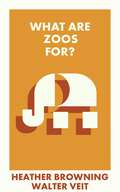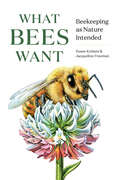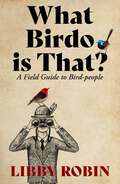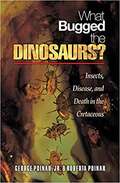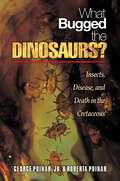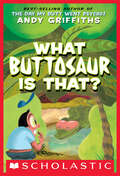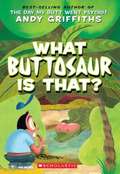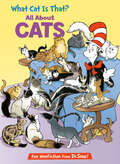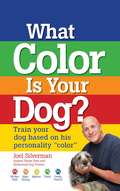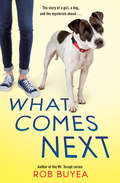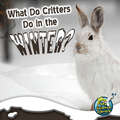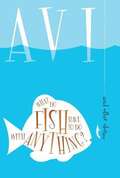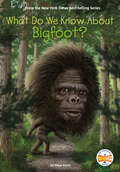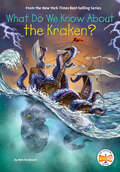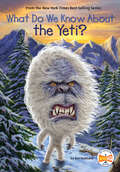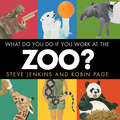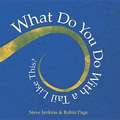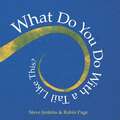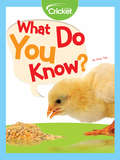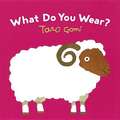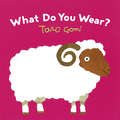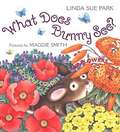- Table View
- List View
What Are Zoos For? (What Is It For?)
by Walter Veit Heather BrowningAre zoos an anachronism in the 21st century when we can watch animals in their natural habitat, close-up from our couches without worrying about cruelty? Should they go the way of other bygone era ‘spectacles’ and ‘attractions’ that we now regard as barbaric? There are vocal campaigners and activists who believe so. Heather Browning and Walter Veit disagree, but they acknowledge there is a case to be answered. In What are Zoos for? they test the common justifications for zoos (entertainment, education, research, conservation) against the evidence and suggest what the best zoos of the future should look like to ensure that they are primarily for animals and not just for people.
What Bees Want: Beekeeping as Nature Intended
by Susan Knilans Jacqueline FreemanBee populations are plummeting. The solution? Give them what they need to live naturally, and they’ll handle the rest. Susan Knilans and Jacqueline Freeman are in love with bees. So in love that they observe their bees—their work, communication, seasonal activity, and more—for hours each day. And with observation came realization: when bees are allowed to live as they would in nature (with smaller hives, no chemicals, freedom to swarm, and little-to-no human interference), they will thrive. Accordingly, Knilans and Freeman have spent decades perfecting the revolutionary practice of preservation beekeeping, guided by the simple question, “What do the bees want?” A surprising page-turner, this instructional book tells the story of their successes and failures, demonstrating what was learned along the way. Sharing preservation beekeeping’s key tenets, the authors provide concrete, simple ways to implement their approach, from finding the right hive location to honing observation skills. This preservation manifesto is a vital addition to any beekeeper’s library, imparting all the joys of a beekeeper's life.
What Birdo is that?: A Field Guide to Bird-people
by Libby RobinThe idea that a bird is good news and needs all our support is probably the only thing amateur birdos, professional zoologists and 'birdscapers'-people who redesign their gardens to support birdlife-have in common. But together they form a conservation community that cares about the future of birds and their habitats, who are working to heal the damage wrought by those who don't notice birds. What Birdo is That? reveals how bird-people in Australia have gone about their craft across the years. Its stories come from wild places - at sea as well as on the land-from dusty archives, from restoration projects, gardens and urban wastelands. They are human stories, but the birds themselves interject and interrupt any self-important anthropocentrism. They educate. They counter the imperialism of the ever-expanding economies of the new millennium. They turn up in unexpected places, giving surprise and joy. This field guide to Australia's bird-people provides a basis for understanding the complex relationship between people and birds in a land of extremes at the forefront of changing climate and habitats.
What Bugged the Dinosaurs?: Insects, Disease, and Death in the Cretaceous
by Roberta Poinar George O. PoinarMillions of years ago in the Cretaceous period, the mighty Tyrannosaurus rex--with its dagger-like teeth for tearing its prey to ribbons--was undoubtedly the fiercest carnivore to roam the Earth. Yet as What Bugged the Dinosaurs? reveals, T. rex was not the only killer. George and Roberta Poinar show how insects--from biting sand flies to disease-causing parasites--dominated life on the planet and played a significant role in the life and death of the dinosaurs. <p><p> The Poinars bring the age of the dinosaurs marvelously to life. Analyzing exotic insects fossilized in Cretaceous amber at three major deposits in Lebanon, Burma, and Canada, they reconstruct the complex ecology of a hostile prehistoric world inhabited by voracious swarms of insects. The Poinars draw upon tantalizing new evidence from their amazing discoveries of disease-producing vertebrate pathogens in Cretaceous blood-sucking flies, as well as intestinal worms and protozoa found in fossilized dinosaur excrement, to provide a unique view of how insects infected with malaria, leishmania, and other pathogens, together with intestinal parasites, could have devastated dinosaur populations. <p><p> A scientific adventure story from the authors whose research inspired Jurassic Park, What Bugged the Dinosaurs? offers compelling evidence of how insects directly and indirectly contributed to the dinosaurs' demise.
What Bugged the Dinosaurs?: Insects, Disease, and Death in the Cretaceous
by Roberta Poinar George PoinarMillions of years ago in the Cretaceous period, the mighty Tyrannosaurus rex--with its dagger-like teeth for tearing its prey to ribbons--was undoubtedly the fiercest carnivore to roam the Earth. Yet as What Bugged the Dinosaurs? reveals, T. rex was not the only killer. George and Roberta Poinar show how insects--from biting sand flies to disease-causing parasites--dominated life on the planet and played a significant role in the life and death of the dinosaurs. The Poinars bring the age of the dinosaurs marvelously to life. Analyzing exotic insects fossilized in Cretaceous amber at three major deposits in Lebanon, Burma, and Canada, they reconstruct the complex ecology of a hostile prehistoric world inhabited by voracious swarms of insects. The Poinars draw upon tantalizing new evidence from their amazing discoveries of disease-producing vertebrate pathogens in Cretaceous blood-sucking flies, as well as intestinal worms and protozoa found in fossilized dinosaur excrement, to provide a unique view of how insects infected with malaria, leishmania, and other pathogens, together with intestinal parasites, could have devastated dinosaur populations. A scientific adventure story from the authors whose research inspired Jurassic Park, What Bugged the Dinosaurs?? offers compelling evidence of how insects directly and indirectly contributed to the dinosaurs' demise.
What Buttosaur Is That? (Andy Griffiths' Butt Series)
by Andy GriffithsFrom the New York Times–bestselling author of the Butt Trilogy comes a silly and informative look at prehistoric butt-related life forms.Tyrannosore-arse Rex versus Tricerabutt: Who kicked more butt?Stenchtiles and Farthropods: Which smelled most foul?Exstinktion: How did the buttosaurs get wiped?This book will tell you everything you need to know but were too grossed out to ask about prehistoric butt-related life forms and the complex stenchology of their environment. Never again will you look like a fool when somebody asks, “What buttosaur is that?”A must-have for every kid with a butt!
What Buttosaur Is That? (Butts #4)
by Andy GriffithsTyrannosore-arse Rex versus Tricerabutt: Who kicked more butt? Stenchtiles and Farthropods: Which smelled most foul? Exstinktion: How did the buttosaurs get wiped? This book will tell you everything you need to know but were too grossed out to ask about prehistoric butt-related life forms and the complex stenchology of their environment. Never again will you look like a fool when somebody asks, "What buttosaur is that?" A must-have for every kid with a butt!
What Cat Is That? All About Cats: All About Cats (The Cat in the Hat's Learning Library)
by Tish RabeLaugh and learn with fun facts about cats, from domestic to wild, kittens to cubs, and more—all told in Dr. Seuss&’s beloved rhyming style and starring the Cat in the Hat! &“I&’m the Cat in the Hat. Let us leave right away to see all the cats we can see in one day.&” The Cat in the Hat&’s Learning Library series combines beloved characters, engaging rhymes, and Seussian illustrations to introduce children to non-fiction topics from the real world! Travel aboard the Kitty-Cat-Copter and learn: • how cats fit through small spaces• how they use their whiskers• why their eyes glow in the dark• and much more! Perfect for story time and for the youngest readers, What Cat Is That? All About Cats also includes an index, glossary, and suggestions for further learning. Look for more books in the Cat in the Hat&’s Learning Library series!If I Ran the Horse Show: All About HorsesClam-I-Am! All About the BeachMiles and Miles of Reptiles: All About ReptilesA Whale of a Tale! All About Porpoises, Dolphins, and WhalesSafari, So Good! All About African WildlifeThere's a Map on My Lap! All About MapsOh, the Lavas That Flow! All About VolcanoesOut of Sight Till Tonight! All About Nocturnal AnimalsOnce upon a Mastodon: All About Prehistoric MammalsOh Say Can You Say What's the Weather Today? All About WeatherThe Cat on the Mat: All About Mindfulness
What Color Is Camouflage?
by Carolyn B. OttoWhat do a fawn and a hermit crab have in common? They both use camouflage to hide from their enemies. A fawn's spots help it blend in with its dappled surroundings, and a hermit crab might be mistaken for an empty shell. This lyrical introduction to camouflage explains how and why a wide variety of animals use it to go undercover. Readers can also hunt for camouflaged animals in every illustration.
What Color Is Your Dog?
by Joel SilvermanThis exciting dog training book is based on the original techniques of Hollywood dog trainer and Animal Planet's Good Dog U host, Joel Silverman. In What Color Is Your Dog? Silverman presents his groundbreaking color-coding technique, developed over his thirty-year career training dogs for film, television, and commercials as well as working with killer whales in Sea World. By determining what color is an owner's dog, he is able to recognize and then enhance his dog's behavior, following the techniques outlined in the book.Silverman's advice for new puppy owners is to develop a strong, trusting relationship with their puppies in their first thirty days. He shuns traditional concepts of beginning the puppy's lessons as soon as the puppy comes home; instead he proposes that new owners spend time having fun, building trust, and enjoying the first month of the relationship. By increasing the dog's trust and "like" of his owner, the dog becomes more willing and eager to please and work with his owner/trainer.The main gist of the book comes from Silverman's color system in which five basic canine personalities or temperaments are assigned colors. With the descriptions of the five colors in hand-Blue (a fearful, rather skittish type dog), Green (a more or less bashful pooch), Yellow (the ideal, easygoing companion dog), Orange (excitable, but relatively under control dog), and Red (the hyper, high-strung dog that bounces off the walks as soon as bark)-an owner is able to determine which color best matches his dog's temperament and approach the dog's lessons accordingly. The dog owner's goal then is to move his dog as close to the middle of the color spectrum (Yellow) as possible by using the training practices outlined in the book.Silverman devotes a full chapter to each of the five colors, explaining what makes each color type tick and how owners should best handle such a dog.The second half of the book focuses on training tools and techniques and teaching specific cues (sit/stay, stay, come, and no). There is also a chapter for the puppy owner giving helpful advice on special techniques to use for puppies.
What Comes Next
by Rob BuyeaFrom the beloved author of the MR. TERUPT and PERFECT SCORE series comes this stand-alone middle-grade novel about a girl who is dealing with the tragic loss of her best friend, and the dog that helps her forge new friendships and find happiness once again.Twelve-year-old Thea and her family are moving to a new town for a fresh start--her parents' bright idea. To Thea, it feels like running away. She lost her best friend, Charlie, in a tragic accident, and in the painful aftermath, she has gone mute. Her two younger sisters, however, are excited about moving, especially after their dad promises that the family will get a rescue puppy. This doesn't change Thea's mind, though, until Jack-Jack bounds into her life and makes it clear that he is no ordinary dog. As she bonds with Jack-Jack, and as the dog's mischievous ways steer her toward someone she can confide in, Thea opens up to the possibility of new friendships and forgiveness, and comes to believe in what cannot be fully explained.
What Curiosity Kills (The Turning #1)
by Helen EllisI want to scream for help, but pain that feels like fire ants has found me. The ants crawl up and out of my knee socks and take over every bit of my flesh. They are between my toes, behind my ears, and in every crevice in between. They scamper across my scalp. They bite. Their bites are unbearable. I twist and scratch within the suffocating comforter. I'm trapped.
What Do Critters Do In The Winter? (My Science Library)
by Julie LundgrenIntroduce your child to different types of animals and how they hibernate, camouflage, and migrate during the cold with the children’s book What Do Critters Do in the Winter?How do different animals survive the winter season? Learn about the different behavioral patterns of critters during the cold months.Fun Storybook Features:This children’s book features a glossary, an index, and post-reading questions to develop comprehension skills.24 pages of vivid photographsLexile 650LAbout Rourke Educational MediaWe proudly publish respectful and relevant non-fiction and fiction titles that represent our diverse readers, and are designed to support reading on a level that has no limits!
What Do Fish Have to Do with Anything? Short Stories
by AviAvi charts the turning points in seven young lives in this extraordinary collection of short stories. In the overlapping years when childhood and adolescence blend and shift like waves and sand, nothing is certain and everything is changing. Avi, one of the most innovative authors writing for young people today, charts the turning points in the lives of seven protagonists in their restless middle years. Here you will meet, among others, the subject of the title story, who wonders why he shouldn't ask questions that have no answers -- is it because he might discover the truth? You'll also encounter a "bad" minister's son who is dared to be good, and a chilling tale of a girl who is haunted by the ghosts of her cats. Always with a surprise built in, an angle unseen, these are stories that step just beyond the edge of the everyday.
What Do We Know About Bigfoot? (What Do We Know About?)
by Steve Korte Who HQThe What Do We Know About? series explores the mysterious, the unknown, and the unexplained. Is the hairy cryptid of the forest fact, myth, or legend? Find out what we really know about Bigfoot in this exciting new series!Presenting What Do We Know About: an exciting new addition to the #1 New York Times Best-Selling Who Was? series!What Do We Know About Bigfoot? lets curious young readers explore what we actually know about the creature's mysterious history. Dive into the facts behind the most well-known footage of the cryptid, the Patterson-Gimlin film, and learn about actual scientific studies conducted to learn whether or not Bigfoot actually exists. Filled with accounts of over a century of potential sightings, this book will have every reader looking for footprints on their next hike. Bigfoot has been the star subject of movies, TV shows, books, and more... but is he really out there?
What Do We Know About the Kraken? (What Do We Know About?)
by Ben Hubbard Who HQThe What Do We Know About? series explores the mysterious, the unknown, and the unexplained. Is this celebrated sea creature fact, myth, or legend? Find out all we know about the Kraken and its history in this exciting book!Presenting What Do We Know About?, an exciting new extension the #1 New York Times Best-Selling Who Was? series!Sea monsters have a long history in lore and literature. Homer first wrote of them in 700 BCE. What Do We Know About the Kraken? lets curious young readers explore what we actually know about this mysterious sea monster's long history. Dive into the facts behind this massive squid-like creature that was first described using the word "Kraken" in the beginning of the eighteenth century. For centuries, sailors have feared the Kraken, which they believe lurks in the ocean, waiting to pull ships beneath the surface with its powerful tentacles. Several famous writers such as Alfred, Lord Tennyson and Jules Verne have described monsters inspired by the Kraken. In this book, readers will also learn about the real creature that might have inspired the Kraken -- the giant squid.
What Do We Know About the Yeti? (What Do We Know About?)
by Ben Hubbard Who HQThe What Do We Know About? series explores the mysterious, the unknown, and the unexplained. Does the ape-like Yeti really roam the Himalayan mountain range?Not quite human and not quite an animal, the Yeti has been the subject of speculation for centuries. In modern times, the Yeti has become a popular cryptid, appearing in movies, books, and TV shows. Although there are many claimed sightings of the Yeti, there is no real evidence that it exists. This elusive cryptid, also known as the Abominable Snowman, remains a mystery. Does the Yeti truly live in the snowy Himalayas? Have the Sherpa who live there spotted him at the highest altitudes? Here are the facts about what we really know about Yeti sightings, research, and lore.
What Do You Do If You Work at the Zoo?
by Steve Jenkins Robin PageFrom Caldecott Honor–winning team Steve Jenkins and Robin Page comes an early introduction to one of young readers&’ favorite places: the zoo! Going to the zoo is so exciting! You might see penguins swimming underwater, snakes sunning in the reptile house, or giraffes eating leaves out of high trees. You might even see people at the zoo, ones just like you! But what do those people do? Caldecott Honor–winning team Steve Jenkins and Robin Page introduce young readers to the people who keep zoo animals safe, healthy, and happy, even though they aren&’t in the wild habitats they&’ve evolved for. From cuddling a baby kangaroo to trimming elephant toenails to playing soccer with a rhino, zookeepers work hard and do some pretty wacky things to take care of the incredible animals we see. So, what would you do if you were in the zookeeper&’s shoes? Turn the page and find out!
What Do You Do With a Tail Like This?
by Steve JenkinsA nose for digging? Ears for seeing? Eyes that squirt blood? Explore the many amazing things animals can do with their ears, eyes, mouths, noses, feet, and tails in this beautifully illustrated interactive guessing book by Steve Jenkins and Robin Page.<P><P> <b>Winner of the Caldecott Honor</b>
What Do You Do with a Tail Like This? (Journeys 2014)
by Steve Jenkins Robin PageA nose for digging? Ears for seeing? Eyes that squirt blood? Explore the many amazing things animals can do with their ears, eyes, mouths, noses, feet, and tails in this interactive guessing book, beautifully illustrated in cut-paper collage, which was awarded a Caldecott Honor.This title has been selected as a Common Core Text Exemplar (Grades K-1, Read Aloud Informational Text).
What Do You Know?
by Amy TaoDo you know how to ride a bike? How to write your name? How to zip up your jacket?
What Do You Wear?
by Taro GomiWhen it comes to getting toddlers dressed, the struggle is real. Enter: Taro Gomi! The bestselling author/illustrator offers a creative and colorful look at animals, reimagining their fur, feathers, and fins as...clothes! A sheep wears a fluffy jacket, a zebra sports striped PJs, a snake is snug in a stocking, and a penguin looks dapper in a classic suit. Young children will be amused by the spirited take on animals, and they'll very likely be convinced that getting dressed is best!
What Do You Wear?
by Taro GomiWhen it comes to getting toddlers dressed, the struggle is real. Enter: Taro Gomi! The bestselling author/illustrator offers a creative and colorful look at animals, reimagining their fur, feathers, and fins as...clothes! A sheep wears a fluffy jacket, a zebra sports striped PJs, a snake is snug in a stocking, and a penguin looks dapper in a classic suit. Young children will be amused by the spirited take on animals, and they'll very likely be convinced that getting dressed is best!
What Does Bunny See?
by Linda Sue ParkA rabbit explores a garden, finding flowers of every color, before hopping home for a nap and dreams of rainbows. Rhyming clues invite the reader to answer the question: What does bunny see? Linda Sue Park’s sprightly verses and Maggie Smith’s cheerful illustrations will delight young children, as each turn of the page yields a colorful surprise.
